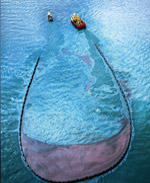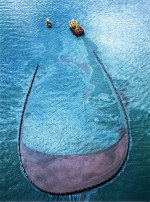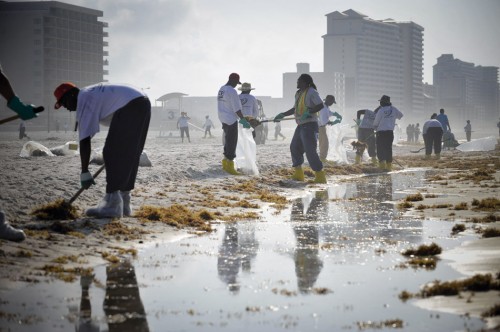
Oil pollution of marine habitats
How oil enters the sea
The public generally takes notice of the problem of marine oil pollutionmarine oil pollutionwhen an oil tanker breaks up in heavy seas or a disaster occurs at an oil platform, one example being the Deepwater HorizonFurther information on this topic is available here:Deepwater Horizonincident in the Gulf of Mexico in spring 2010. In such cases, oil slicks often drift towards the coasts and kill seabirds and marine mammals such as seals. Yet in reality, spectacular oil tanker disasters account for only around 10 per cent of global marine oil pollution.Further information on this topic is available here:
Most of the oil enters the seas along less obvious pathways, making it correspondingly difficult to precisely estimate global oil inputs into the marine environment. Around 5 per cent comes from natural sources, and approximately 35 per cent comes from tanker traffic and other shipping operations, including illegal discharges and tank cleaning. Oil inputs also include volatile oil constituents which are emitted into the atmosphere during various types of burning processes and then enter the water. This atmospheric share, together with inputs from municipal and industrial effluents and from oil rigs, accounts for 45 per cent. A further 5 per cent comes from undefined sources.
Although vegetable oils such as palm oil are now being produced in increasing quantities and are therefore also entering the atmosphere, oil pollution still mainly consists of various types of oil from fossil sources, created over millions of years from deposits of microscopically small marine organisms, mainly diatoms.oil from fossil sources, created over millions of years from deposits of microscopically small marine organisms, mainly diatoms.Further information on this topic is available here:
 4.13 > Oil enters the sea along various pathways. Around one third comes from regular accident-free shipping operations.
4.13 > Oil enters the sea along various pathways. Around one third comes from regular accident-free shipping operations.- This crude oil consists of around 10,000 individual substances, with hydrocarbons being the main component (more than 95 per cent). However, the precise composition can vary considerably according to the place of origin. Crude oil also contains heavy metals and nitrogen compounds.
The extent to which mineral oils and their components adversely affect the various marine habitats and their flora and fauna varies considerably from case to case. Major oil spills have the greatest and most disruptive impact, although their effects are in most cases regionally limited. Since the Torrey Canyon tanker disaster in 1967, when around 115,000 tonnes of crude oil were spilled on a reef off the southern English coast, resulting in the largest oil pollution incident ever recorded up to that time, numerous field studies have been carried out which now provide a very clear overview of the impacts of various types of oil on organisms and habitats. However, one oil disaster is quite never the same as another, and the precise effects of an accidental oil spill depend on a variety of conditions.
A crucial factor, for example, is how quickly the oil breaks down or sinks from the surface of the sea to the lower depths, where the damage it causes is likely to be relatively limited. This breakdown is influenced by various physical, chemical and biological processes. Depending on a variety of different environmental conditions such as temperature, nutrient content in the water, wave action etc., the breakdown of the petroleum hydrocarbons may take shorter or longer periods of time. During the first few hours or even during the first few weeks, the oil is modified by the following chemical and physical processes:- evaporation of volatile constituents;
- spreading of the spilled oil in large oil slicks drifting on the surface waters;
- formation of dispersions (small oil droplets in the water column) and emulsions (larger droplets of oil-in-water or water-in-oil);
- photooxidation (molecular changes to the oil constituents caused by natural sunlight) and solution.
- 4.14 > In the sea, oil is modified and broken down in a variety of ways. Generally, when an oil spill occurs, the oil immediately forms large slicks which float on the water’s surface. A proportion of the oil evaporates or sinks, but other oil constituents are broken down by bacteria or destroyed by solar radiation. Finally, the oil solidifies into clumps (tarballs), which are more resistant to bacterial breakdown.

- Processes such as sedimentation and breakdown by bacteria, on the other hand, may continue for months or even years, although in some cases, under favourable conditions, they may be completed within a matter of days.
The reason for this discrepancy is that, firstly, the various substance groups contained in the oil undergo biological breakdown at different rates. The speed of breakdown depends primarily on the molecular structure of the oil constituents. The more complex the hydrocarbon molecules, the longer it takes for the oil to be broken down by microorganisms. Secondly, the rate at which the various hydrocarbons are broken down is increased by the following factors:
- high temperatures, promoting bacterial activity;
- a large surface area (if necessary, the surface area of the slick can be increased through the use of dispersants, i.e. surface-active agents [surfactants] which promote the formation of dispersions);
- good oxygen supply for the bacteria;
- good nutrient supply for the bacteria;
- low number of predator organisms which would reduce the number of bacteria.
 4.15 > A specially equipped ship deploys a boom, consisting of inflatable floats, in an attempt to contain the crude oil spilled at sea by the oil tanker Sea Empress after it went aground off the coast of Wales in 1996. In rough seas, however, the use of these skimmers has little effect.
4.15 > A specially equipped ship deploys a boom, consisting of inflatable floats, in an attempt to contain the crude oil spilled at sea by the oil tanker Sea Empress after it went aground off the coast of Wales in 1996. In rough seas, however, the use of these skimmers has little effect.
How oil damages habitats
It is generally not possible to protect an entire coastline from the effects of a major oil spill, so the authorities have to set priorities for their oil spill response. It goes without saying that designated conservation areas, such as national parks, or sensitive marine areas are particularly worth protecting and are given high priority in clean-up efforts. As a rule, however, these areas are too large to be protected in their entirety. Here, sensitivity rankings can facilitate the oil spill response: these describe the general sensitivity of the various shoreline types to oil pollution. In exceptional cases, it may even be possible to define “sacrificial areas” which are less important from a nature conservation perspective and where no protective measures are taken.
When defining these sensitivity rankings, one factor which is taken into account is whether the section of coastline is a “high-energy” area, e.g. with rocky or sandy shores that are subjected to direct wave action, or whether they are relatively calm, “low-energy” areas such as the Wadden Sea, which are protected by sandbanks or offshore islands. Of course, within the major habitats described here, other more detailed sensitivity rankings can be defined for a targeted oil spill response.
EXPOSED ROCKY AND SANDY SHORES: Exposed rocky and sandy shores are classed as areas of relatively low sensitivity because the oil deposited by the sea is cleared very swiftly by wave action. Nonetheless, major oil spills can change the composition of biological communities in these habitats over the longer term. In such cases, populations of former dominant species such as crustaceans and molluscs may decline. In rocky crevices, rough gravel and on mussel beds, the oil pollution may persist for many years.
SANDY BEACHES: Here, a different situation applies. The extent to which the oil penetrates the ground and how long it remains there depend primarily on the structure of the beach. An extensive beach with little surf and with branching channels, for example, is far more vulnerable than a steep beach with a less diverse structure. Coarse-grained sediment facilitates oil penetration, makes the clean-up process more difficult, and increases the risk of follow-up damage from re-surfacing oil. Beach areas used as habitats or breeding sites by endangered species, such as turtles, are classed as particularly sensitive.
CORAL REEFS: Corals are also highly sensitive to oil pollution. Various studies show that damaged coral reefs are very slow to regenerate. Oil pollution can also affect entire communities. For example, less sensitive species of algae can colonize oil-contaminated areas which were previously coral habitats. Very little research has so far been undertaken to investigate how oil spills affect the relationship between corals and the many species associated with them. The linkage between numerous specialized species and the great significance of symbioses within these ecosystems indicate that far-reaching and long-term impacts can be anticipated after major oil spills.
MANGROVES: Mangrove habitats react with particular sensitivity to oil pollution. Here, an oil spill can inflict severe damage on trees and the sensitive organisms living in them and in sediment. This damage is caused by toxic hydrocarbons, but can also occur as a result of oil cover, which shuts off the oxygen and freshwater supply. The regeneration of damaged populations of flora and fauna is a lengthy process. As the harmful hydrocarbons are removed from sediment very slowly in mangroves, habitat recovery is further delayed.
SOFT SUBSTRATES AND SANDBANKS: Sections of coastline with soft substrates and sandbanks, such as the Wadden Sea on the North Sea coast, are classed as particularly or highly sensitive. The organisms living at great density in and on the sediment provide the basic food supply for fish and birds. Although in most cases, very little oil penetrates the often water-saturated fine pores of muddy sediment, these areas are generally densely populated by burrowing organisms whose activities cause the oil to sink deeper into the ground. On the other hand, the stirring and mixing of sediment by these organisms – known as bioturbation – also help to break down the oil by churning up the sediment, exposing deeper layers to the air and bringing oily sediment to the surface. As this activity promotes a healthy oxygen supply, the oil is then broken down more quickly by bacteria. If the organisms in the sediment have been killed by the oil, however, bioturbation ceases and the oil remains in the ground for longer, causing long-term habitat damage.
SALT MARSHES: Very few studies have been carried out to investigate how oil affects invertebrate organisms found in salt marshes, such as insects and worms. The vegetation, however, can suffer long-term damage from oil pollution, with major implications for breeding and resting birds in the salt marshes, whose plumage may be covered in oil or which could lose their basic food supply.
To sum up, the following regeneration periods can be assumed:- Exposed rocky and sandy shores: between a few months and 5 years;
- Protected rocky shores and coral reefs: between 2 and more than 10 years;
- Protected soft substrates, salt marshes, mangroves: between 2 and more than 20 years.
Extra Info Oiled and poisoned – the effects on flora and fauna

Responses to oil spills and pollution
In scenarios other than disasters that occur in deep waters, such as the explosion at the oil drilling rig in the Gulf of Mexico in spring 2010, an oil spill disaster response is most effective while the slick is still drifting on the water surface. From a technical perspective, some countries prefer to use exclusively mechanical methods to contain oil spills, such as oil skimmers or booms that form floating barriers on the water, while others opt for chemical methods, mainly involving the use of dispersants, which are usually dropped on the slick in large quantities from aircraft. The effectiveness of these chemicals is heavily dependent on the type and condition of the oil, however. A further limiting factor is that these dispersants can generally only be used for a short time after the spill has occurred, as the chemical and physical processes described above begin to impair their effectiveness after only a few hours. If the oil slicks are drifting towards sensitive sections of shoreline, using these agents may be a sensible option, however. The dispersants drive the oil from the surface down into deeper waters, reducing the risk that seabirds or sensitive flora will become coated with oil. Following the explosion at the Deepwater Horizon drilling rig in 2010, however, the oil flowed out of the borehole at great depth and entered the entire water column, partly as a massive cloud of oil. Very little experience has been gained in responding to disasters of this type and on this scale. As an initial response, massive quantities of dispersants were deployed, with currently unforeseeable ecological consequences. Bioremediation can also be successfully deployed in suitable – i.e. nutrient-poor – marine areas. This involves seeding the water with nutrients to promote the growth of bacteria that break down oil.
- 4.17 > Although the quantities of oil being transported across the oceans have increased considerably since the 1970s, the amount of marine oil pollution caused by oil tanker disasters, technical defects or negligence has fallen dramatically. The sharp decrease in tanker traffic in the late 1970s was caused by the economic crisis which occurred during that period. The statistics cover oil spills above 7 tonnes; records of smaller spills are somewhat patchy.

- No matter which strategy is deployed, it can only be successful and effective as part of a broader national contingency plan in which well-trained emergency teams implement a coherent and well-thought-out response. In the US, Germany, other North Sea states and certain other countries, such contingency plans have been in place for a number of years. In these countries, the days when the authorities often failed to adopt a prompt, effective or appropriate response to oil spills due to a lack of clear responsibilities, equipment and personnel are over. On their own, however, technical management strategies are not enough. Global and regional agreements are required to protect the sea from oil pollution, and mechanisms need to be in place to monitor compliance with them. A positive example is the International Convention for the Prevention of Pollution from Ships,International Convention for the Prevention of Pollution from Ships,1973, as modified by the Protocol of 1978 relating thereto (MARPOL 73/78), which from 1983 formed the basis for the designation of marine protected areas where tanker traffic is wholly or partly restricted. As a result of the Convention, there was a reduction in the number of oil tanker disasters during the 1980s. In addition to other provisions on operational discharges of oil, MARPOL 73/78 also paved the way for the introduction of double hull tankers. The United States’ 1990 Oil Pollution Act and the International Management Code for the Safe Operation of Ships and for Pollution Prevention (ISM Code) adopted by the International Maritime Organization (IMO) in 1998 also contributed to the further decrease in oil pollution over subsequent decades.Further information on this topic is available here:
- 4.18 > Workers on a beach at the popular Gulf Shores resort in the US remove sacks of oil-covered algae. The resort, along the coast of Alabama, is one of the communities in the Gulf of Mexico which have been polluted by oil from the Deepwater Horizon disaster in June 2010.

The outlook for the future – cautious optimism
Marine oil pollution has undoubtedly decreased in recent decades. International conventions, the designation of protected areas and the mandatory introduction of double hull tankers have all made a contribution here. At the same time, as the Deepwater Horizon disaster clearly demonstrates, the situation for the marine environment continues to give cause for concern. Furthermore, the illegal discharge of oil during tank-cleaning operations, which still accounts for one third of oil pollution, cannot be tackled effectively without more stringent controls and tough penalties. Combating oil pollution in shallow waters such as the Wadden Sea will also continue to be a problem in future as response vessels generally cannot operate in waters of less than 2 metres depth.